Page no. 7.8 Ex. 7.1
Q1.
Answer :
The given problem requires definitions of various terms.
(i) Line segment:
A line segment AB can be defined as the part of the line with end points A and B, whereA and B are the two points of the line.
It is denoted by
Let us take a line with two points A and B
This is a line AB
While,
This is a line segment AB.
(ii) Collinear points:
When three or more points lie on the same line; they are said to be collinear.
Example:
Let us take a line l. P, Q, R points lie on it.
So,
Here, P, Q and R are collinear points.
(iii) Parallel lines:
Two or more lines are said to be parallel to each other if there is no point of intersection between them.
For Example:
Since, there is no point of intersection between l and m, they are parallel.
(iv) Intersecting lines:
Two or more lines are said to be intersecting lines if they meet each other at a point or they have a common point.
For Example:
l and m are the two lines both passing through point O. Hence, they are intersecting lines.
(v) Concurrent lines:
Two or more lines are said to be concurrent if they all pass through a common point or there exist a point common to all of them.
For Example:
m, n, o and p are concurrent as they all have a common point O.
(vi) Ray:
A ray is defined as the part of the line with one end point such that it can be extended infinitely in the other direction.
It is represented by
For Example:
Here, is a ray as it has one end point A and it can be extended indefinitely in other direction.
(vii) Half-line:
A half-line can be defined as a part of the line which has one end point and extends indefinitely in the other direction. It is different from ray as the end point is not included in the half-line.
For example,
When A is included in the part, then it is called a ray AB, but when A is not included then is called a half-line AB.
Q2.
Answer :
(i) Let us take a point A.
If we try to draw lines passing through this point A, we can see that we can draw many lines.
Therefore, infinite number of lines can pass through a given point.
(ii) Let us take two lines l and m, and intersect them.
As, we can see here the two lines have only one point in common that is O.
Therefore, there is only one point where two distinct lines can intersect.
Q3.
Answer :
(i) In this problem we are given two points P and Q.
If we try to join these two points through a line segment, we can see that there can be only one such line segment PQ.
Therefore, given two points, only one line segment is determined by them.
(ii) In the given problem, we are given three collinear points P, Q and R. Collinear points lie on the same line, so they can be represented as
So, the various line segments determined here are PQ, QR and PR.
Q4.
Answer :
(i) False
The given statement is false, as it is not necessary that the two lines always intersect. In the case of parallel lines, the two lines never intersect or there is no common point between them.
(ii) False
The given statement is false, as there is only one point common between two intersecting lines. So, two lines cannot intersect at two points.
(iii) False
A line segment is a part of line defined by two end points, so it is always of a definite length. Hence, the given statement is false.
(iv) True
The given statement is true as a unique line can be determined by minimum of two distinct points.
(v) False
A ray is defined as a part of the line with one end point, where the other end can be stretched indefinitely. Therefore, a ray cannot have a finite length.
(vi) True
The given statement is true as a ray is defined as a part of the line with one end point, where the other end can be stretched indefinitely.
(vii) False
A line segment is a part of line defined by two end points. So the given statement is false as a line segment has two end points.
(viii) False
While denoting a ray, the first letter denotes the end point and the second one denotes the end which can be extended. So, for ray AB, A is the end point and B is the end which can be stretched while for ray BA, B is the end point and A the end which can be stretched. Therefore, ray AB is not the same as ray BA.
(ix) False
The given statement is false as infinite number of lines can pass through a given point.
(x) False
Two lines are said to be coincident if they lie exactly on top of each other, which means that they have all the points in common. So the given statement is false.
Q5.
Answer :
(i) A line segment is a part of line defined by two end points. So in the given figure 7.17, five line segments are:
(1) AC
(2) CD
(3) AP
(4) PQ
(5) RS
(ii) A ray is the part of line with one end point and one end which can be extended. So in the given figure 7.17, five rays are:
(1)
(2)
(3)
(4)
(5)
(iii) Collinear points are the points which are present on the same line. In the present figure 7.17, there are two sets of four collinear points.
(1) A, P, R, B
(2) C, D, Q, S
(iv) In the given figure 7.17, two pairs of non intersecting line segments are:
(1) AB and CS
(2) AC and PQ
Q6.
Answer :
(i) Two distinct points in a plane determine a unique line.
(ii) Two distinct lines in a plane cannot have more than one point in common.
(iii) Given a line and a point, not on the line, there is one and only perpendicular line which passes through the given point and is perpendicular to the given line.
(iv) A line separates a plain into three parts namely the two half planes and the line itself.
Page no. 7.9 Formative Assessment_VSA
Q1.
Answer :
If we have a single point A then we can draw infinite number of lines through it, while if we have two points A and B; then only one unique line passes through both of them.
When we have one point,
When we have two points,
Therefore, a minimum of two distinct points are required to determine a unique line.
Q2.
Answer :
Given two distinct points, only one unique line can be drawn passing through both of them.
For example, if we have two distinct points A and B, only one line is there which passes through both of them.
Q3.
Answer :
Given a single point, then we can draw infinite number of lines through that point.
For example: If we have a point A, then there are infinite numbers of lines passing through it.
Here, lines m, n, o and p all pass through point A.
Q4.
Answer :
Two distinct lines can intersect at only point, as there is only one common point between two intersecting lines.
For example, if l and m are two intersecting lines then there is only one common point O between them. This is the point of intersection.
Q5.
Answer :
A line which is not present in the plane can intersect the plane at only one single point.
Q6.
Answer :
Two distinct planes can intersect at only one unique line, which is common to both of them and one line is made up of infinite points.
Therefore, two distinct planes can intersect at infinite points.
Q7.
Answer :
If we look at two intersecting plane, we can see that there is only one unique line at which the two planes intersect.
Therefore, two distinct planes can intersect each other at a single unique line as only a single line is common between two intersecting planes.
Q8.
Answer :
If we have two distinct points, then we can draw infinite number of planes passing through those two points. While if we have three distinct non collinear points, only a single unique plane can be drawn passing through those three points.
Therefore, a minimum of three distinct non collinear points are required to get a unique plane.
Q9.
Answer :
Given three distinct points A, B and C in a plane, they can either be collinear or non collinear.
If they are collinear, then there can be only one line joining them.
If they are non collinear, then there can be three lines joining them.
For example, if we have three distinct non collinear points P, Q and R. Then we can draw three lines l, m and n joining them.
Q10.
Answer :
Given a line and a distinct point not lying on the line, only a single plane can be drawn through both of them as there can be only plane which can accommodate both the line and the point together.
Let us take a line l and a point A, as we can see there can be only plane which pass through both of them.
Q11.
Answer :
Given two distinct points, we can draw many planes passing through them. Therefore, infinite number of planes can be drawn passing through two distinct points or two points can be common to infinite number of planes.
Q12.
Answer :
The number of planes that can pass through three distinct points is dependent on the arrangement of the points.
- If the points are collinear, then infinite number of planes may pass through the three distinct points.
- If the points are non collinear, then only one unique plane can pass through the three distinct points.
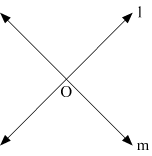
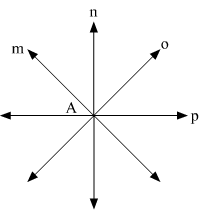

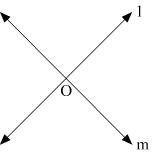
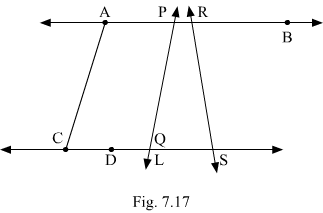
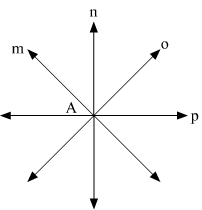
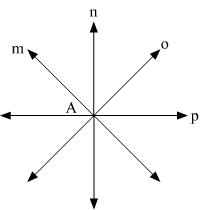
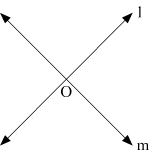
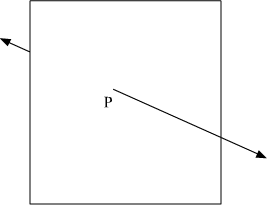

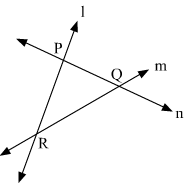
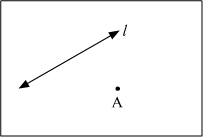
Leave a Reply